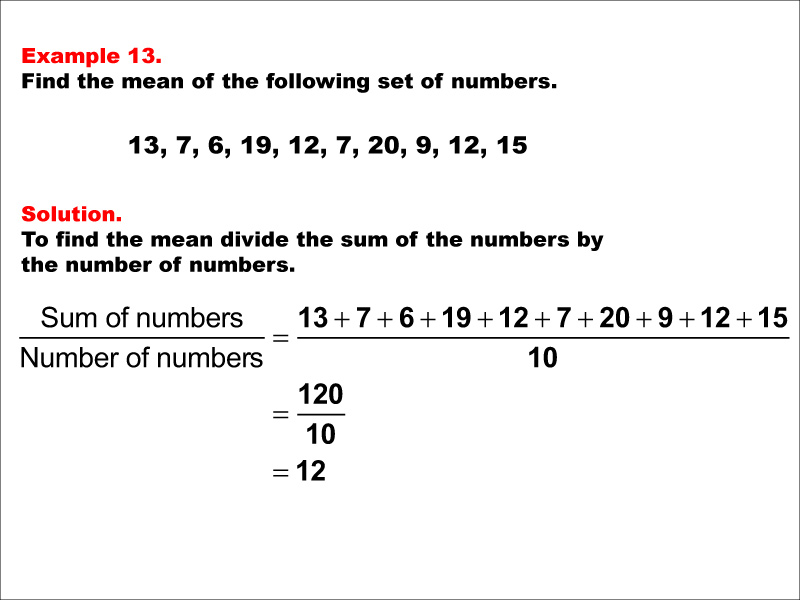
Display Title
Math Example--Measures of Central Tendency--Mean: Example 13
Display Title
Math Example--Measures of Central Tendency--Mean: Example 13

Topic
Measures of Central Tendency
Description
This example illustrates the calculation of the mean for the numbers 13, 7, 6, 19, 12, 7, 20, 9, 12, and 15. The process involves summing all values (120) and dividing by the count of numbers (10), resulting in a mean of 12. This example demonstrates how the mean can provide a central value that represents a dataset with repeated numbers and a wide range of values.
Understanding measures of central tendency, especially the mean, is fundamental in statistics and data analysis. These measures allow us to condense large datasets into single, representative values, facilitating comparisons and providing insights. Mastering these concepts equips students with the tools to interpret data effectively and make informed decisions across various academic and real-world contexts.
Providing multiple examples is crucial for deepening students' understanding of the mean. Each new example reinforces the calculation process while introducing slight variations in the data, helping students recognize that the concept applies universally, regardless of the specific numbers involved. This approach builds confidence and prepares students to apply the concept flexibly in various real-world contexts, from analyzing scientific data to interpreting economic trends.
Teacher Script: "Let's examine our thirteenth example of calculating the mean. Notice how our dataset includes repeated numbers (7 and 12) and a wide range of values from 6 to 20. As we work through this, consider how these elements might influence our final result. How does the mean we calculated (12) compare to the individual values in our set? Remember, the mean gives us a 'typical' value for our dataset, but it might not match any single data point exactly. This example illustrates how the mean can represent a dataset even when it includes diverse values and repetitions, providing a balanced view of the entire set of numbers."
For a complete collection of math examples related to Measures of Central Tendency click on this link: Math Examples: Measures of Central Tendency: Mean Collection.
| Common Core Standards | CCSS.MATH.CONTENT.6.SP.B.4, CCSS.MATH.CONTENT.6.SP.A.3, CCSS.MATH.CONTENT.HSS.ID.A.2, CCSS.MATH.CONTENT.HSS.ID.A.3 |
|---|---|
| Grade Range | 6 - 12 |
| Curriculum Nodes |
Algebra • Probability and Data Analysis • Data Analysis |
| Copyright Year | 2014 |
| Keywords | data analysis, tutorials, measures of central tendency, mean, average |